The general trend since the 1990’s is to larger wheels with lower profile and wider tires. Until roughly 20 years ago, only exotic cars had wheel rims larger than 16 inches in diameter as original equipment. The last two decades have seen dramatic increases in rim sizes even on prosaic, non performance vehicles like minivans.
This can be attributed in part to aesthetic considerations, bigger wheels being more noticeable and considered attractive. Bigger wheels require more expensive and faster wearing tires. Large tires offer better cornering and stability in extreme driving on dry roads. They are a requirement for many vehicles with engines generating over 250 horsepower — a very rare breed until the late 1990’s.
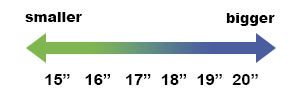
Small
- cheaper tires
- better pothole resistance
- quieter
- softer ride
- adequate up to approx. 180 hp
- lower risk of aquaplaning
Mid-sized
- good all-around compromise
Large
- sharper cornering
- larger wheel allows for larger brakes
- more stopping traction
- enhanced appearance
- fast wearing, costly tires
- increased risk of rim damage
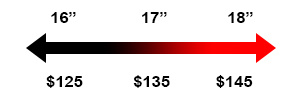
tire in three different sizes
to fit a Chevrolet Cavalier
Wheel Diameter
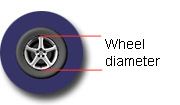
Here is how you can determine the diameter of the wheels on your car. Every automobile tire bears a marking that follows this format:
P195/65R15
The very last number (here shown in bold numbers) indicates the diameter of the wheel on which the tire is mounted. In this case, it is a 15 inch wheel. The following chart sheds light on wheel sizes and what they mean.
| WHEEL | DESCRIPTION | APPLICATIONS (en équipement standard) |
|---|---|---|
| 13-inch 14 inch | Lightweight and low-cost wheels associated with economy cars. Soft riding, long tread life, less expensive tires. | Toyota Echo, base VW Golf |
| 15-inch | Good compromise found on entry-level compact cars, mid-size cars and minivans. | Base Volkswagen Jetta, base Hyundai Elantra |
| 16-inch 17-inch | Once upon a time, a sports car exclusive, Today’s mainstream size on compact cars. | Volkswagen Golf, Hyundai Elantra, Toyota Camry |
| 18-inch | Frequently an optional size on compacts, standard on mid-size cars. | Honda Civic, Toyota Camry, Mazda 3 |
| 19-inch and above | Low profile tires in these large rim sizes are often not designed with Canadian roads in mind.Costly, more vulnerable to road damage, often shod with relatively hard riding tires. Much less practical in winter | BMW 3-Series, Mercedes GLK and GLC, Nissan Murano, Tesla Model 3 |
Tire Sidewall Height
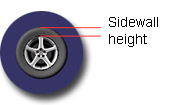
The height of the sidewall of a tire, or tire profile, also influences the behaviour of a car. To determine the tire profile, find the following type of indication on the sidewall:
P195/65R15
The second number (in bold characters) indicates the aspect ratio. The higher it is, the higher the sidewall (and the profile). The reference chart located at the bottom of this page shows the true meaning of this number.
| ASPECT RATIO | DESCRIPTION |
|---|---|
| 70-75 | Old-school lower-cost tire that has now mostly disappeared. Comfortable, less precise turn-initiation. Long wearing. Lower stability at higher speeds. |
| 60-65 | Common profile, compromise between precision and comfort. Many tires available with these profiles. |
| 55 | Sportier tire, slightly more precise and a bit harder riding, noisier. |
| 50 | Precise high performance tire, high levels of precision and grip, but less comfort. Smaller sidewall means wheels are more vulnerable. |
| 45 and lower | Performance tires, generally wide that make few concessions to comfort. Wears quickly, high price. Bumps and potholes should definitely be avoided! |
Why a low profile tire?
A lower profile tire is more precise because its sidewall, being shorter and stiffer, will flex less in cornering and transition maneuvers. This higher rigidity also causes the tire to be less comfortable, because tire sidewalls act like springs whenever they hit pavement irregularities. A stiffer sidewall will allow the impact to be felt more acutely by the occupants and a shorter one will make the wheel more likely to be damaged in the event of such an impact.
Is there a meaningful difference?
A tire with a markedly lower profile will definitely be more precise, but in everyday life and on public roads, the type and the quality of the tire will likely have a greater influence on your driving experience than a slightly lower profile. Handling is usually more than acceptable with an upgraded tire in the original wheel size. If you are thinking about fitting lower profile tires to your car, see our subsection on one and plus two conversions.
Comment lire un pneu
| Exemple | Signification | Explication de l’exemple |
|---|---|---|
| P195/65R15 225/55R17 | The first letter (nowadays sometimes omitted) indicates the intended use of the tire: P for a passenger car, LT for a light truck. The first number tells the tread width, in millimeters. It usually ranges from 155 to 245. The second number indicates the height of the sidewall; it is a percentage of the tread width. Mostly between 80 and 45. The letter R means that the tire is a radial. The last number is the wheel diameter in inches. | P: passenger car 195: 195 mm wide tread 65: sidewall with a height of 65 % x 195 mm, equaling approximately 127 mm 15: tire intended to be mounted on a 15” wheel |
| 80V 84T | This marking is often found following the dimension of the tire. The number is an index (not an actual value) that determines the maximum load that the tire can withstand.The letter is the speed index; set by the manufacturer, it indicated the maximum speed tolerated by the tire, a measure of its heat resistance. | 80 : this tire can withstand 450 kg (992 lbs). V : maximum speed of 240 km/h. 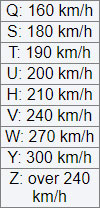 |
| treadwear 300 | The number following the TREADWEAR inscription is a relative measure of the wear resistance of the tire. It is meant to compare tires among themselves. An index of 100 means that during a standardized test, the tire lasted 49 000 km; real-life durability will be much lower and depends on many other factors. | |
| traction aa traction b | The letter (or letters if AA) only reports the braking traction capacity of the tire during a test performed on wet asphalt and concrete surfaces. | AA (new designation) indicates the best performance and C, the worst. |
| temperature A | This is measure of the resistance of the tire to overheating during two tests, one performed at 160 km/h, the other at 187 km/h. | A: the tire passed both tests B: the tire only passed the 160 km/h test C: the tire failed both tests |
| M+S, M/S, M&S | Abbreviation for “Mud and Snow”, meaning that the tire is deemed to be able to cope with both of these surfaces. Almost meaningless and getting worse, as it is governed by no standard and tire manufacturers give it to many three-season tires. | |
 | Symbol that indicates that a winter tire meets the requirement of a stringent snow traction standard, unlike M+S. This standard was adopted by the Rubber Association of Canada and incorporated in the federal Motor Vehicle Safety Act. |
